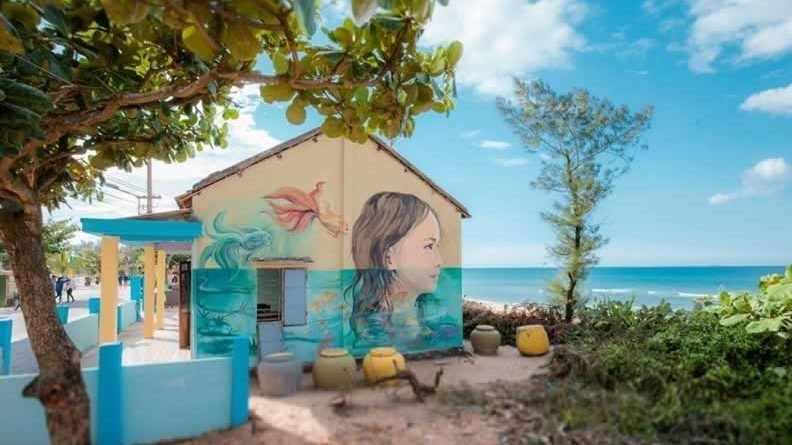After Tam Thanh village in Tam Thanh commune, Tam Ky city, Quang Nam province was coated with vivid mural paintings in June 2016, it has become an attractive tourist destination for visitors to Vietnam’s central coastal region.
Since then, additional mural villages have sprung up in Ta Hai island commune, Nui Thanh district in Quang Nam province, Binh Hai commune, Binh Son district and An Binh commune, Ly Son district, in Quang Ngai province. Mural art also covers streets and areas in Da Nang city, Quang Binh, Dong Thap, and Quang Ninh provinces.
In Hanoi in particular, vault murals have been inaugurated in dozens of residential areas and public spaces, attracting the enthusiastic participation of local authorities and organisations. Most recently, a section of the fresco street of Phung Hung in Hoan Kiem district was revived with beautiful mural paintings.
The mural arts should be encouraged if it is purely produced under community projects with the aim of beautifying the surrounding space and benefiting a specific community. But when it is incorporated with a wider vision to makeover an entire place and turn it into a tourist attraction, the issue is beyond simple and needs thorough consideration.
When Tam Thanh mural village was unveiled in 2016, Park Kyoung Chul, who was currently Director of Korea Foundation in Hanoi, said that in the Republic of Korea, the mural paintings need to be redecorated after seven to 10 years. He hoped that the maintenance and repair of the murals in Tam Thanh would be done after at least five years.
Unfortunately, things didn’t quite go quite as he had expected. Thanks to the beautiful murals, Tam Thanh has quickly established itself as a tourist attraction since the summer of 2016. The prices of land in the village have increased, and more tourist services have been launched to serve visitors. With improved economic stability, local households began the construction of new houses. Within just one year after the mural village was introduced to the public, many of the mural walls had been smashed.
It is undeniable that the mural paintings have greatly contributed to the makeover in not only appearance but also in improving the socio-economic situation of Tam Thanh. However, it might be unreasonable for local villagers to stay in old and cramp houses just because of the colourfully decorated walls outside.
In the 3D mural village of Thanh Thuy in Quang Ngai province, local fishermen have left the sea to open tourist services and street shops to serve visitors. It is thought that the murals painted in the village do not blend well with the local cultural background, as some of the paintings feature Japanese landscapes and Western-styled dome houses.
The newly-inaugurated fresco street of Phung Hung in Hanoi has also raised controversial arguments for authentic Hanoians. The section which hosts the mural paintings is a popular corner for fans of beer and street food in Hanoi. Consequently, elders, youngsters and children excitedly flock to one side of the section for photos and selfies, while people are drinking beer and barbeque smoke is blowing up on the other site of the pavement.
The art is forcefully placed into a busy and crowded atmosphere, preventing visitors from admiring the paintings and meditating about the messages that the painters wanted to portray.
In May this year, the Korean Foundation will continue providing support for Tam Thanh village to repair and redecorate the mural walls. The foundation plans to request that the local authorities and residents sign an agreement to protect and preserve the mural paintings for at least five years. However, it is a hard decision for the locals to decide whether they should follow the aligned agreement or upgrade their accommodation.
Mural arts have been set up in Vietnam with the target of luring visitors and boosting local tourism. However, the development of the hospitality sector requires a long-term vision and suitable infrastructure, as well as management capacity over arising problems.
The requirements have not yet been met, even ignored in some localities, leading to the rushed and uncontrolled launch of mural paintings. Thorough consideration is needed in addressing the problem so that the art will be exercised and admired in the correct manner.
















